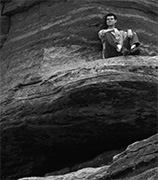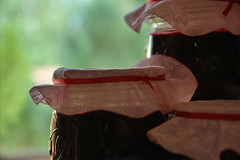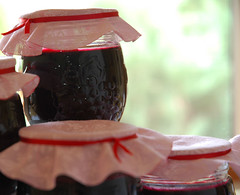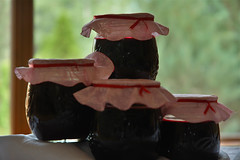Jelly-making in the Rockies
High altitude is great for crisp dry air, beautiful winter snow and alpine flowers. It is not good for baking, candy making or jelly making. I nearly fumbled the jelly this year by trying to follow the recipe. I don't see any high-altitude directions, so assumed there weren't any major differences. How wrong I was!
Trying to get the pectin, fruit juice and sugar to set at 220 Fahrenheit is next to impossible. Why? Water at this altitude boils at 200 degrees, not 212. By the time you reach 220 degrees you've well over burned your jelly or candy. That means the jelly-set temperature is closer to 207 degrees, adjusted for percentage - not geometric difference. For those higher in altitude than the mile-high city, I suggest you start testing your jelly around 206 degrees on a frozen saucer(freeze a few saucers for multiple tests).
Barometric pressure also plays a factor. It changes widely and quickly in the mountains and can really mess up your candies and jellies if not watched after.
A candy maker told me that in this area you have to watch the weather for a solid clear sky and check for storm patterns when making your candies or they won't come out.
Chocolate and fudge is a little more forgiving. Still, I've even had some crystallized fudge from Rocky Mountain Chocolate Factory before so even well seasoned candy makers can have their off-days.
So how did the black raspberry -- red currant jelly come out? Much of the water boiled out leaving a very thick, very hard set, very strong jelly. Not burned, thank goodness, but it almost did.
It's as black and dense as midnight though clear as a jewel and spreads on a deep, rich, royal purple. It would probably do better spooned out and diluted to be served as a syrup because of its intense raspberry flavor, but still goes well with the hearty flavor of hearty-grained or strong buttermilk breads. It probably wouldn't do well on water crackers.
I had another interesting and fun basic geometric math problem to solve while making the jelly. The recipe calls for 2.25 cups of sugar for every 2.5 cups of juice after straining. All the juice had been strained in the pot it would be made in and I didn't want to make a mess of the dark juice. I remembered that you could convert metric volume into liters - that, after all, is the definition of a liter. Liters could be converted into cups, which could then be multiplied by the ratio of sugar to juice for the correct amount of sugar without ever needing to pour the juice out of the pot.
The diameter of the pot is 24cm. The depth of the juice was 2.6cm. ( pi*(24/2)^2 ) * 2.6 is roughly 1176.212 milliliters or 1.176212 liters. There are 4.22675282 cups in a liter. That ends up being roughly 5 cups of juice, which means 4.5 cups of sugar was needed. It was a perfect example of my math teacher saying "You may want to do this someday..." becoming true.
Fantastic jelly, geeky math fun, and a story to tell. What more could you want to do with your evening ... other than sharing a piece of jelly emblazoned toast with your inspiring wife?
Trying to get the pectin, fruit juice and sugar to set at 220 Fahrenheit is next to impossible. Why? Water at this altitude boils at 200 degrees, not 212. By the time you reach 220 degrees you've well over burned your jelly or candy. That means the jelly-set temperature is closer to 207 degrees, adjusted for percentage - not geometric difference. For those higher in altitude than the mile-high city, I suggest you start testing your jelly around 206 degrees on a frozen saucer(freeze a few saucers for multiple tests).
Barometric pressure also plays a factor. It changes widely and quickly in the mountains and can really mess up your candies and jellies if not watched after.
A candy maker told me that in this area you have to watch the weather for a solid clear sky and check for storm patterns when making your candies or they won't come out.
Chocolate and fudge is a little more forgiving. Still, I've even had some crystallized fudge from Rocky Mountain Chocolate Factory before so even well seasoned candy makers can have their off-days.
So how did the black raspberry -- red currant jelly come out? Much of the water boiled out leaving a very thick, very hard set, very strong jelly. Not burned, thank goodness, but it almost did.
It's as black and dense as midnight though clear as a jewel and spreads on a deep, rich, royal purple. It would probably do better spooned out and diluted to be served as a syrup because of its intense raspberry flavor, but still goes well with the hearty flavor of hearty-grained or strong buttermilk breads. It probably wouldn't do well on water crackers.
I had another interesting and fun basic geometric math problem to solve while making the jelly. The recipe calls for 2.25 cups of sugar for every 2.5 cups of juice after straining. All the juice had been strained in the pot it would be made in and I didn't want to make a mess of the dark juice. I remembered that you could convert metric volume into liters - that, after all, is the definition of a liter. Liters could be converted into cups, which could then be multiplied by the ratio of sugar to juice for the correct amount of sugar without ever needing to pour the juice out of the pot.
The diameter of the pot is 24cm. The depth of the juice was 2.6cm. ( pi*(24/2)^2 ) * 2.6 is roughly 1176.212 milliliters or 1.176212 liters. There are 4.22675282 cups in a liter. That ends up being roughly 5 cups of juice, which means 4.5 cups of sugar was needed. It was a perfect example of my math teacher saying "You may want to do this someday..." becoming true.
Fantastic jelly, geeky math fun, and a story to tell. What more could you want to do with your evening ... other than sharing a piece of jelly emblazoned toast with your inspiring wife?
Labels: altitude, geeky, high altitude, jelly, jelly making, math, metric conversions











